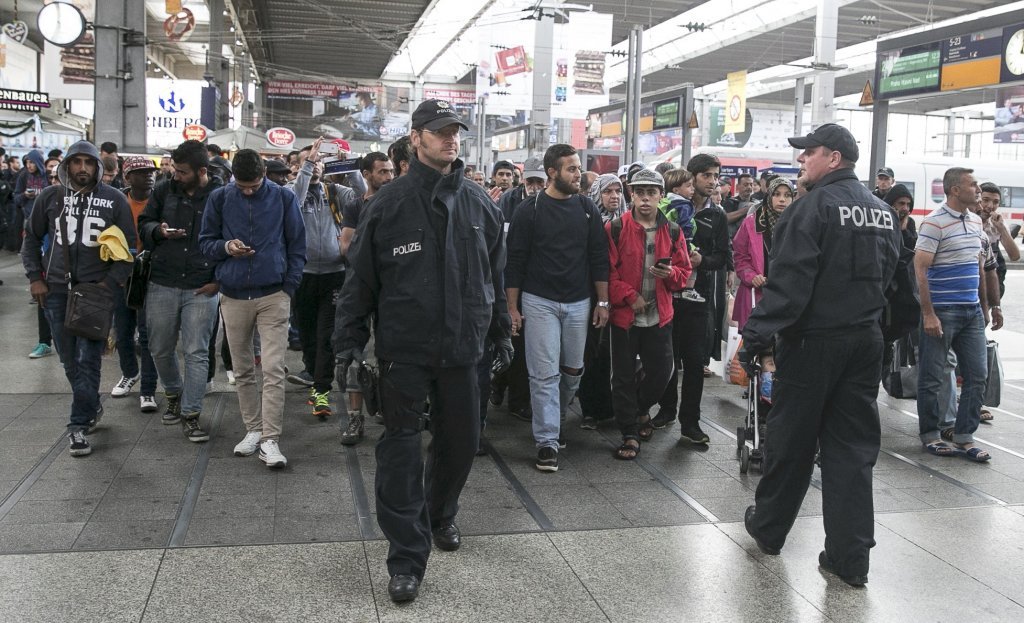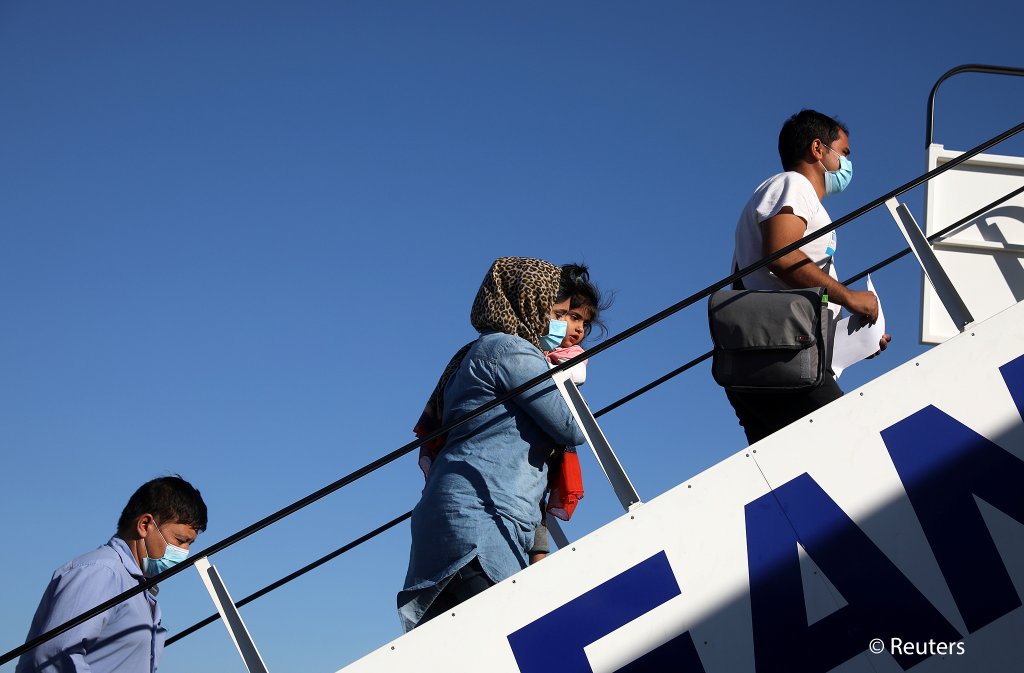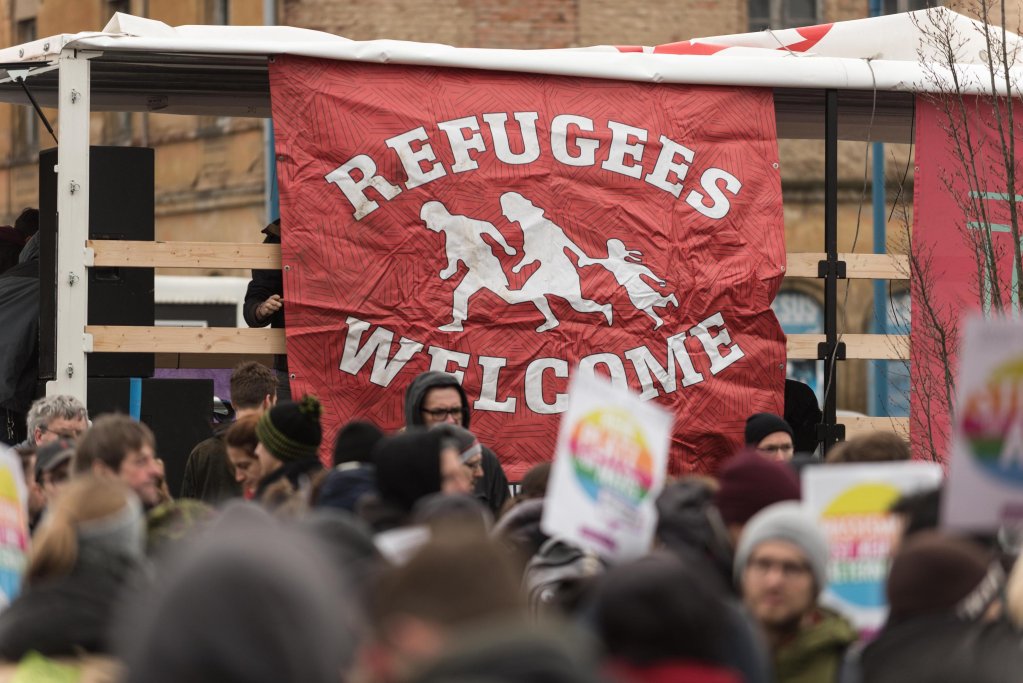The year 2015 is considered a pivotal moment for migration and asylum policy in the European Union, particularly in Germany. As hundreds of thousands of refugees made their way to the country, a series of events and policy decisions unfolded that would redefine German society and its stance on migration. What happened in the summer and autumn of 2015?
Many words and images from the so-called "refugee summer" 10 years ago have burned themselves into Germany’s collective memory. A decade later we look back on the important milestones of a year that redefined migration policy and reshaped a country.
April 18–19: Disaster off Sicily
A trawler carrying more than 800 people capsizes in the Strait of Sicily. Only about 30 survive. The tragedy, one of the worst in the Mediterranean in decades, shocks Europe and prompts the EU to strengthen its naval presence off Libya.
July 15: Reem Sahwil and Merkel’s dilemma
In a school dialogue in the German city of Rostock, Palestinian student Reem Sahwil describes her family’s insecure residency status to Chancellor Angela Merkel. Merkel responds that Germany cannot take in everyone, then awkwardly comforts the crying teenager. Critics accuse her of being coldhearted.
August 25: Dublin rules suspended for Syrians
Germany announces that Syrians will no longer be sent back to the EU country of first entry under the Dublin Regulation. Their asylum cases will instead be processed in Germany.

August 26: Heidenau & Parndorf
In Heidenau (Saxony), far-right extremists attack a refugee shelter. Merkel visits and is heckled by demonstrators.
That same day, Austrian police discover 71 dead migrants in a refrigerated truck on the A4 motorway near Parndorf. They had suffocated inside.
August 31: 'Wir schaffen das'
At her Berlin summer press conference, Merkel calls managing the refugee influx a “great national task” and utters the words that will define her chancellorship: “Wir schaffen das” (“We can do this”).

September 2: Alan Kurdi
The photo of three-year-old Alan Kurdi, drowned on a Turkish beach, travels around the world. It becomes a symbol of the refugee crisis and intensifies the debate over Europe’s responsibility.
September 3: Orbán criticizes German refugee policy
Hungarian Prime Minister Viktor Orbán denounces German refugee policy, saying refugees only want to reach Germany, not stay in Hungary. In a guest commentary for the Frankfurter Allgemeine Zeitung, Hungary’s Prime Minister Viktor Orbán warned that the refugee influx could have "explosive consequences for the whole of Europe." He condemned the EU’s approach as "madness" and blamed what he called "misguided immigration policy" for the crisis.
September 4–5: The welcome trains
Germany and Austria agree to take in thousands of refugees stranded in Hungary. When the first trains arrive at Munich Hauptbahnhof, volunteers line the platforms with food, water, toys, and applause. Many describe the atmosphere as euphoric, a powerful expression of "Willkommenskultur" -- the "welcome culture" that came to symbolize Germany’s humanitarian response in that moment. Religious leaders, including Cardinal Reinhard Marx and Bishop Heinrich Bedford-Strohm, are among those personally welcoming the new arrivals.

September 6: Pope Francis’ call
Pope Francis urges every parish, monastery, and church institution in Europe to take in one refugee family -- "a concrete gesture of charity."

September 13: Borders return
Germany reinstates border controls at the Austrian frontier. Schengen's principle of open travel is suspended, foreshadowing longer-term restrictions.
September 22: EU Relocation decision
The EU agrees to redistribute 120,000 asylum seekers from Italy and Greece across member states. In practice, only around 33,000 are ever relocated.
September 27: Gauck’s reality check
At the opening of Intercultural Week, German President Joachim Gauck declares: "We want to help. We are big-hearted. But our means are finite." His words reflected a growing tension in German society: between the "Willkommenskultur" and rising public anxiety over integration, housing, security, and social services. Gauck’s remarks were widely interpreted as a call for realism amid the emotional debates of late summer 2015.
October 9: First EU relocation flight
In Rome, 20 Eritreans board a plane to Sweden. It is the first relocation flight under the EU’s scheme, but numbers remain meagre.

October 15: Asylum law tightened
Germany’s Asylum Procedure Acceleration Act comes into force. The law is designed to ease pressure on the overwhelmed asylum system. Albania, Kosovo, and Montenegro are classified as "safe countries of origin", which means applicants from these states have little chance of being granted asylum and can be returned more quickly. The law also replaces cash benefits with vouchers or in-kind support in many reception centers, aiming to reduce "pull factors."
November 29: EU–Turkey joint action plan
The EU and Turkey reach an agreement on closer cooperation to reduce irregular crossings into Greece. Ankara commits to strengthening border controls and readmitting migrants who enter the EU illegally, in exchange for 3 billion euros in aid, progress on visa liberalization, and the reopening of EU accession talks.
This deal lays the groundwork for the March 2016 EU-Turkey Statement, which became the centerpiece of Europe’s strategy to curb arrivals along the Eastern Mediterranean route. While the agreement sharply reduced boat crossings to the Greek islands, it also left tens of thousands of people stranded in Greece and made the EU more dependent on Turkey’s cooperation, a relationship critics described as both fragile and transactional.
December 7: BAMF Figures
The Federal Office for Migration and Refugees published the following figures in its report on migration for 2015:
- 965,000 registrations in the EASY system (“Erstverteilung der Asylbegehrenden” – the IT system used for the initial registration and distribution of asylum seekers to Germany’s federal states). Because EASY did not record personal data, the figure included double counts and onward journeys. After corrections, the actual number of arrivals was about 890,000.
- 476,649 asylum applications in 2015 (+135 percent vs. 2014).
- 355,000 applications pending.

December 11: Word of the year
The Society for the German Language names “Flüchtlinge” (refugees) as Germany’s Word of the Year.
December 25–26: Christmas arson attacks
Arson attacks on a refugee shelter under construction in Schwäbisch Gmünd in the southern state of Baden-Württemberg, and two homes of immigrant families in Wallerstein in Bavaria. These are among 850 attacks on refugee shelters in 2015 (4x more than 2014). North Rhine-Westphalia alone recorded 187 cases (six times higher than the year before). Officials warn of rising radicalization and daily xenophobic violence.

December 31 / January 1: Cologne New Year’s Eve
Widespread sexual assaults and thefts near Cologne’s central station, largely blamed on men of North African origin, dominate headlines. The incident fuels demands for faster deportations and stricter asylum laws, boosting support for far-right parties.
The Legacy of 2015
The so-called "refugee summer" left behind a dual legacy of compassion and conflict. On one side, hundreds of thousands of volunteers, churches, and NGOs mobilized across Germany, creating an unprecedented wave of solidarity symbolized by cheering crowds at Munich’s central station. However, 2015 also revealed the darker undercurrents of society: the Federal Criminal Police Office (BKA) recorded over 850 attacks on refugee shelters -- more than four times the number recorded in 2014 -- along with daily incidents of xenophobic violence against individuals.

The political aftershocks were arguably just as profound. Chancellor Merkel’s “Wir schaffen das” became both a rallying cry and a provocation. While many refugees gradually settled, found work, and entered schools and training programs, resistance to her open-door stance is seen by some to have fueled the rapid rise of the far-right Alternative für Deutschland (AfD). Founded in 2013 as a eurosceptic party, it was polling between six to10 percent by late 2015 and channeling resentment about migration into electoral gains. Other far-right movements like PEGIDA mobilized tens of thousands on the streets, and racist rhetoric moved from the fringes into mainstream debate.
Ten years on, the legacy of 2015 remains deeply ambivalent. It reshaped German asylum law, anchored external agreements such as the EU-Turkey deal, and made migration a defining political fault line even beyond its borders.
Read AlsoSix pivotal moments of the 2015 'migrant crisis'
With KNA
